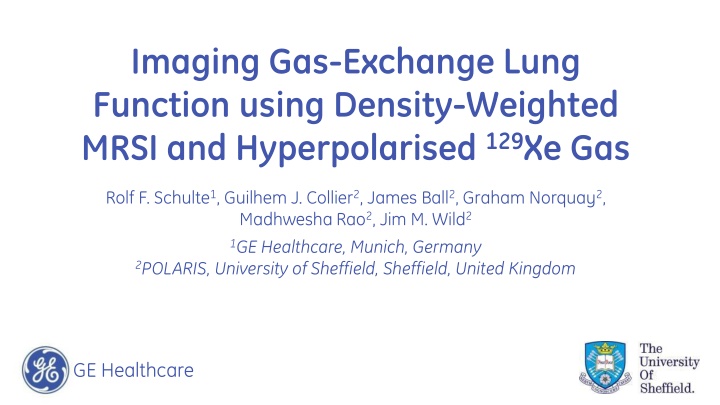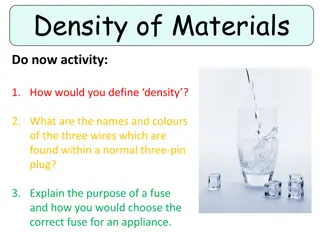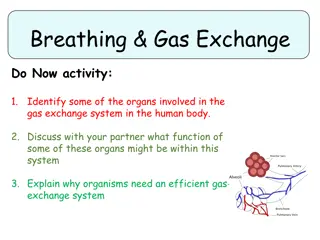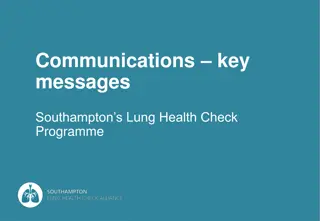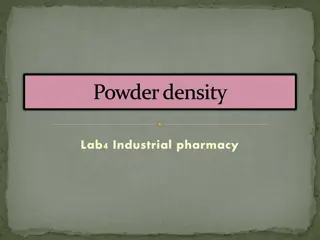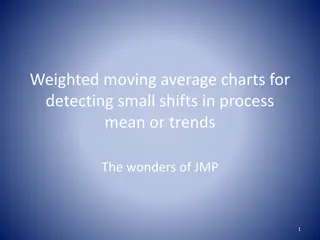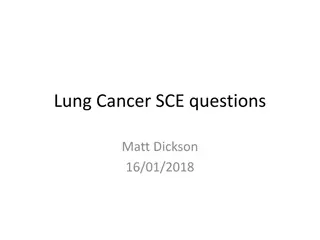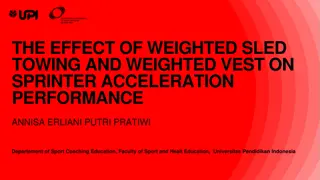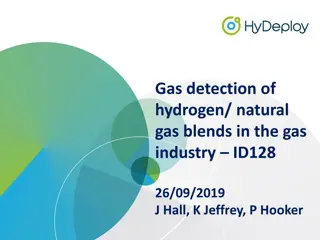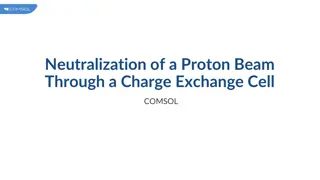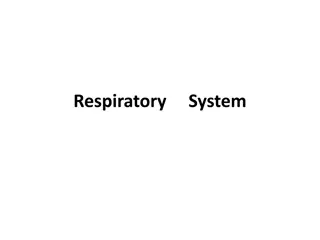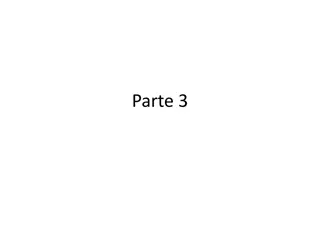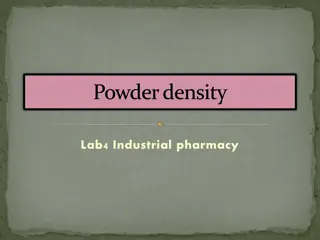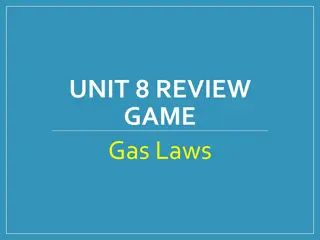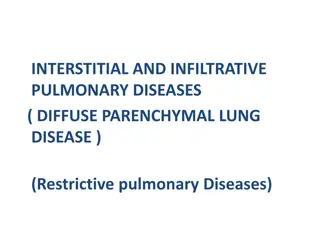Gas Exchange in Lung Function Using Density-Weighted MRSI
Advanced imaging techniques like Density-Weighted MRSI and Hyperpolarised 129Xe Gas play a crucial role in assessing lung function by detecting spatially resolved abnormalities. These methods are particularly valuable in conditions such as COPD, asthma, and idiopathic pulmonary fibrosis, as well as in evaluating long-term lung damage post COVID-19 infection. The use of Hyperpolarised 129Xe gas, with its unique properties and applications, offers a promising approach to non-invasively study gas exchange in the lungs. This article provides insights into the technology, methodology, and clinical applications of imaging gas exchange for better understanding and management of respiratory conditions.
Download Presentation

Please find below an Image/Link to download the presentation.
The content on the website is provided AS IS for your information and personal use only. It may not be sold, licensed, or shared on other websites without obtaining consent from the author.If you encounter any issues during the download, it is possible that the publisher has removed the file from their server.
You are allowed to download the files provided on this website for personal or commercial use, subject to the condition that they are used lawfully. All files are the property of their respective owners.
The content on the website is provided AS IS for your information and personal use only. It may not be sold, licensed, or shared on other websites without obtaining consent from the author.
E N D
Presentation Transcript
Imaging Gas-Exchange Lung Function using Density-Weighted MRSI and Hyperpolarised 129Xe Gas Rolf F. Schulte1, Guilhem J. Collier2, James Ball2, Graham Norquay2, Madhwesha Rao2, Jim M. Wild2 1GE Healthcare, Munich, Germany 2POLARIS, University of Sheffield, Sheffield, United Kingdom GE Healthcare
Motivation Hyperpolarised 129Xe: only method to detect lung function spatially resolved Applications: chronic obstructive pulmonary disease (COPD), asthma and idiopathic pulmonary fibrosis Long COVID-19: ~10-20% of infected people (pre-omicron) exhibit longer-term damages of lungs, kidneys, heart and brain Polarean finished Phase 3 clinical trial (lung resection)
Introduction Xenon-129: spin- , natural abundance=26.4%, ?129?? Hyperpolarisation of 129Xe gas via Spin-Exchange Optical Pumping (SEOP) Transport/temporary storage in Tedlar bags (T1=minutes-hours) 14 ?1? =-35.3MHz @3T GE Healthcare
Introduction GE Healthcare Source: Muggler, Altes; review, JMRI 2013; https://doi.org/10.1002/jmri.23844
Introduction Boundary conditions T2* 1ms (3T) or 2ms (1.5T) in red blood cells Breath-hold < 15s 1-2% signal level of gas phase Fast uptake (ms) Chemical shifts: lung gas=1ppm, RBC=218ppm, tissue=198ppm Published approaches of mapping gas uptake 3D radial 1-point Dixon 2D spiral CSI 3D radial spectroscopic imaging Goal Explore 3D density-weighted MRSI Compare to 3D radial SI Kaushik SS, Robertson SH, Freeman MS, He M, Kelly KT, Roos JE, Rackley CR, Foster WM, McAdams HP, Driehuys B. Single-breath clinical imaging of hyperpolarized (129)Xe in the airspaces, barrier, and red blood cells using an interleaved 3D radial 1-point Dixon acquisition. Magn Reson Med 2016;75(4):1434-1443. Doganay O, Chen M, Matin T, Rigolli M, Phillips JA, McIntyre A, Gleeson FV. Magnetic resonance imaging of the time course of hyperpolarized (129)Xe gas exchange in the human lungs and heart. Eur Radiol 2019;29(5):2283-2292. Collier GJ, Eaden JA, Hughes PJC, Bianchi SM, Stewart NJ, Weatherley ND, Norquay G, Schulte RF, Wild JM. Dissolved (129) Xe lung MRI with four-echo 3D radial spectroscopic imaging: Quantification of regional gas transfer in idiopathic pulmonary fibrosis. Magn Reson Med 2021;85(5):2622-2633.
Methods: Frequency-Tailored Excitation Excite gas phase with 1% of dissolved phase Partially self-refocused for reduced TE Direct linear-LSQ design For 3T (0.6ms) and 1.5T (1.2ms)
Methods: Density-Weighted MRSI Impose apodisation during acquisition Improved PSF & SNR Peak integration metabolite maps
Methods: Reconstruction & Quantification Density-weighted MRSI Spectral apodisation Zero-filling Slow FT or gridding & FFT Spectral FFT Peak integration Corrections for flip angles, T2* Mask calculation (threshold) Maps + (masked) ratio maps
Experimental Home-built SEOP polariser MR450w (1.5T) and PET-MR (3T) with MNS 129Xe vest coil (CMRS, MKE) 2 healthy volunteers Comparison: 2 breath-holds; TR=8ms, flip angle=10 & 0.1 1) 3D DW-MRSI: 14 14 7, FOV=30 30 15cm3, voxel size=(2.1cm)3, 1799 phase encodes, 88 spectral points, BW=20kHz, TR=8ms acq. Time = 14.4s 2) 3D radial EPSI: voxel size=(2cm)3, FOV=(40cm)3, BW=31.25kHz, 1728 radial projections, 4TEs per projection with TE=0.704ms Fidall PSD, Matlab reconstruction 1L of enriched 129Xe gas polarised to ~30%
Results 1.5T 3T gas blood gas blood/tissue tissue blood/tissue tissue blood/gas blood blood-gas shift
Discussion and Conclusion High SNR Similar values as in literature Full spectral information robustness + confidence RF pulse robust against mis-setting f0 by 200Hz Possibly use non-enriched xenon gas (cheaper) Reconstruction on scanner exporting dicom s
